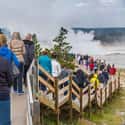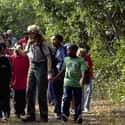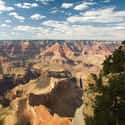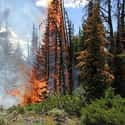-
(#10) Tourists Can Spread Disease And Introduce Invasive Species To Parks
Quagga and zebra mussels have slowly made their way across the United States thanks to hitching rides on boats and being transported to other bodies of water by fishermen and boaters. Most water vehicles, including those without motors like canoes and kayaks, must be cleaned and inspected before they're allowed into national parks. These rules are put in place to protect the ecosystem of each park, as outside animals, plants, and insects can cause harm.
Unfortunately, it isn't always easy. Visitors can carry invasive seeds into parks via their clothing, cars, or pets. Sometimes seeds are stuck in mud attached to wheels or boots. Many parks also restrict visitors from bringing their own firewood since it may be carrying invasive insects like gypsy moths or diseases such as Emerald ash borer.
-
(#8) Visitors Take Pieces Of The Park Home With Them, Sometimes Animals
Many people realize trying to take a rattlesnake as a souvenir or loading a baby bison into an SUV is not the wisest decision, but somehow strange stories such as these happen every year in national parks. Visitors often think that taking one stick or rock as a souvenir won't hurt anything, but if all 305 million people who visited national parks in 2016 took an item, these protected areas wouldn't stay beautiful for very long.
Petrified Forest National Park in Arizona is slowly being depleted thanks to visitors seeking free souvenirs. At one point, it was noted 12 tons of petrified wood was disappearing into people's pockets and bags each year. It's important to remember that taking natural items out of national parks is considered illegal, and in many cases also comes with the threat of heavy fines.
-
(#3) Crowds Are Congesting Trails And Trampling The Paths
More visitors to a park means more people out on the trails. While everyone deserves a chance to see the amazing vistas and plant life, too many people hiking at once can sometimes ruin the experience. And since not all people appreciate nature in the same way, not everyone is going to have a good time. Despite having to deal with park visitors taking selfies in front of every other tree or complaining about the lack of cell service, the trails themselves are hurting from all those feet.
"We're concerned about impacts on resources, vegetation, soils... and impacts to wildlife that frequent those areas," Mary Riddle of Glacier National Park commented. In addition to trails being overcrowded, there is danger to the environment if visitors go off the trail or park their cars in non-designated areas. However, it is true that the national parks were created in order for people to visit, walk around, and be enjoyed. As one park lover said, "What do we do, stop people from coming?"
-
(#14) There Aren't Enough Funds Or Park Rangers To Keep Up With Demands
As the number of visitors to national parks swells each year, it becomes apparent the parks do not have the funding to keep with the needs of the crowds. Leaky buildings, structures built with hazardous materials, and deteriorating roads are just some of the problems facing the parks, and after they announced the delay of about $11.5 billion worth of maintenance projects in 2015, things probably aren't going to be upgraded or fixed any time soon.
The people employed by the national parks are in trouble too. Budget cuts have led to understaffed parks, including rangers (who take on many more jobs than just giving tours) and emergency rescue workers who save both hikers and animals.
CEO and President of National Parks Conservation Association, Theresa Pierno said:
Superintendents operate parks on shoestring budgets and can't afford to fill open positions, leaving current staff to work long hours and perform the jobs of multiple people. The same park ranger greeting visitors may also need to lead a tour, fix a display and clean a bathroom because there is simply no one else to do it.
-
(#1) The Popularity Of National Parks Are Surging And Attracting People From All Over The World
To put just how many people visit national parks into perspective, the combined parks saw around 305 million visitors in 2015, while all of the world's Disney parks combined had about 149 million visitors in 2014. Disneyland may be the happiest place on earth but apparently more people want to look at rocks and trees. Thanks to several successful campaigns in recent years, including a centennial anniversary in 2016, America's national parks are more popular than ever.
People wanting to reconnect with nature or experience the authentic natural beauty of the world account for many visitors, but many people travel from other countries to see America's national parks as well: 20% of tourists at Yosemite in 2010 were from areas outside the US. Although parks like Yellowstone, Grand Canyon, and Yosemite are the most well known, you may be surprised to discover that the Great Smokey Mountains actually draw the biggest crowds.
-
(#11) They Start Fires Which Can End Up Destroying Millions Of Acres
While many wildfires are ignited by lightning, many more are started by careless humans. Discarded cigarette butts and unattended campfires have been seen as the cause for almost 90% of the wildfires started in the United States, many of which have affected national parks. In 1988, 50 of the 248 fires near Yellowstone were inside the park, causing damage to 36% of the park and costing $120 million to put out.
In addition to destroying the landscape, fires in national parks can endanger the lives of both animals and humans. Fire is also something that can be easily avoided when proper care is taken by smokers and around campfires. Jail time and hefty fines are also great reminders to be careful with flames.
New Random Displays Display All By Ranking
About This Tool
In recent years, the number of tourists to American national parks has surged. However, incidents of tourists failing to comply with the rules and being injured by animals have also increased significantly, causing concerns among management agencies and environmental protection organizations. Many tourists approach wild animals without authorization, causing their own casualties, or injuring animals. For example, a Canadian tourist once drove away a small bison, causing the bison herd to no longer accept the small bison, and the staff had to euthanize the small bison.
More tourist violations have increased the workload of the park staff and are gradually destroying the ecological environment of the national parks. In some extreme cases, tourists even died. You could find 15 descriptions of terrible tourist behaviors with the generator.
Our data comes from Ranker, If you want to participate in the ranking of items displayed on this page, please click here.
















